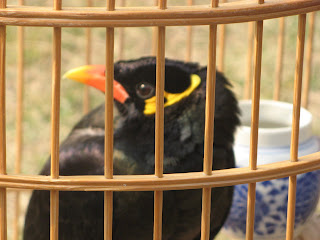I love weekends (who doesn't?), especially when it brings nice, sunny weather. Today was the first time I'd seen the sun in a week, so I was really itching to get outside and enjoy the day. My goal was to get to Bei Da - aka Peking University - specifically the Arthur M. Sackler Museum of Art and Archaeology. I was supposed to go with my friend Liz, but she called at the last minute saying she couldn't make it. Since I was already at Bei Da when she called, I decided to go by myself.
The museum is tucked up in the northwest corner of Bei Da, so I had a pleasant walk across campus. Like Beijing itself, Bei Da is a mix of old and new, and you can really see it in the architecture. Traditional Chinese buildings with rounded roof tiles and colorful designs are nestled right next to massive structures of concrete and steel. The museum is of the former variety, located next to a very pretty pond with a pavilion and stone bridge. The whole place felt very tranquil after spending 45 minutes dodging cars and enduring two crowded buses to get there.
The museum itself was likewise a carthartic experience - quiet, peaceful, and devoid of people. I really appreciated the English captions that went along with each item. It was the best and most comprehensive guide I've seen in a Chinese museum so far. Thank you, Mr. Sackler. Most of the items on exhibit were excavated from burial tombs, so the majority of what I saw consisted of three-legged ritual urns, pots, and ceramic figures (guardians of the dead). They also had a small section on Tibetan Buddhist ceremonial items, which were really cool, but I had to use my imagination as to their purpose and function because there weren't any English translations. There were a couple of early hominid skeletons too.
After seeing all there was to see, I headed for Bei Da Lake. Like me, there were quite a few people taking advantage of the nice weather. People sat on the many rocks surrounding the lake, taking pictures, eating, and chatting. I walked towards the large pagoda that sat at the east end of the lake. I passed the grave of Edgar Snow, "American Friend To The Chinese People" and author of "Red Star Over China," as well as many cherry blossom trees in full bloom.
This was one of first times that I've ventured outside of my usual home-to-Bei Wai route by myself, and I have to say that I rather enjoy going solo around Beijing. It's very rewarding when I manage to get somewhere on my own - it's a great feeling to be able to ask someone for directions, for them to actually understand what I'm saying, for them to tell me, for me to understand them (even if I have to ask them to repeat it 3 times), and finally, to correctly find the place. It's a great confidence boost.


